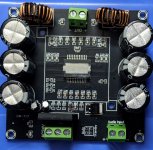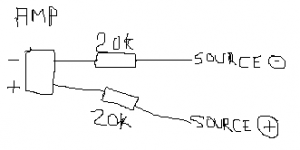This is 37v smps
€ 26,83 4%OFF | HBP500W AC 200-240V 500W +/-30V 35V 40V 45V 50V 55V 60V 65V 70V Amplifier Switching Power Supply Audio Board PSU
HBP500W AC 200 240V 500W +/ 30V 35V 40V 45V 50V 55V 60V 65V 70V Amplifier Switching Power Supply Audio Board PSU|Circuits| - AliExpress
Edit: I forgot to thank you for the quick reply!
€ 26,83 4%OFF | HBP500W AC 200-240V 500W +/-30V 35V 40V 45V 50V 55V 60V 65V 70V Amplifier Switching Power Supply Audio Board PSU
HBP500W AC 200 240V 500W +/ 30V 35V 40V 45V 50V 55V 60V 65V 70V Amplifier Switching Power Supply Audio Board PSU|Circuits| - AliExpress
Edit: I forgot to thank you for the quick reply!
Last edited:
DC input.
At the 230Vac SMPS input you have three terminals: two for the two 230Vac leads and one for ground (in the middle). If you use a 230Vac power cable and plug with ground, try to disconnect the ground-wire from the board (make no short-circuit with the free end of the ground wire!). A ground-wire can introduce noise in the system.
At the 230Vac SMPS input you have three terminals: two for the two 230Vac leads and one for ground (in the middle). If you use a 230Vac power cable and plug with ground, try to disconnect the ground-wire from the board (make no short-circuit with the free end of the ground wire!). A ground-wire can introduce noise in the system.
As your SMPS is not connected to protective earth, your power supply is "floating" with respect to earth potential, both for primary and secondary. You can fix that secondary potential to any potential with respect to earth as long as the voltage does not exceed the insulation limit and you do not create a closed circuit with a different potential with respect to earth. In case of doubt, you do it first time through a small fuse that will blow if there is a closed circuit you have overlooked.
When I was a boy (long ago) we made rather high impedance amplifier circuits. The buildings in those days did not have protective earth pins. A rule back then was that the ground of an amplifier circuit should be connected to chassis (which had no connection to earth). That would remove hum noise that typically changed volume when I was close to the chassis. This is my first suggestion to you: remove protective earth from the chassis and make a connection to amplifier ground instead. That on its own may solve your problems. Protective earth on chassis is good for avoiding electrical chock but may cause hum problems depending on the quality of the protective earth connection.
If you have sporadic noise passing through the input, it is a good idea to try to lower the input impedance. Very high input impedance "invites" noise to enter as well. How much you can lower the input impedance depends on your source. My high quality headphone amp can pull 100 Ohm or even less. Start with 20K. With your board, connect the 20K resistor between the two input terminals, in parallel with the input from the source.
NB: Make sure that your input wires are connected correctly with source GND to amplifier GND and source signal to amplifier signal. Crossing the wires will work to some extent but introduce a lot of hum.
When I was a boy (long ago) we made rather high impedance amplifier circuits. The buildings in those days did not have protective earth pins. A rule back then was that the ground of an amplifier circuit should be connected to chassis (which had no connection to earth). That would remove hum noise that typically changed volume when I was close to the chassis. This is my first suggestion to you: remove protective earth from the chassis and make a connection to amplifier ground instead. That on its own may solve your problems. Protective earth on chassis is good for avoiding electrical chock but may cause hum problems depending on the quality of the protective earth connection.
If you have sporadic noise passing through the input, it is a good idea to try to lower the input impedance. Very high input impedance "invites" noise to enter as well. How much you can lower the input impedance depends on your source. My high quality headphone amp can pull 100 Ohm or even less. Start with 20K. With your board, connect the 20K resistor between the two input terminals, in parallel with the input from the source.
NB: Make sure that your input wires are connected correctly with source GND to amplifier GND and source signal to amplifier signal. Crossing the wires will work to some extent but introduce a lot of hum.
Last edited:
help mod fix hum for use as mono subwoofer amp
my board is a bit different with yours, HW-717 version ??!
I bought it for only ~10$
I plan to use it as a subwoofer amp, it is strong and gives a solid bass but it has noise and hum loud in the background (seem like 50hz noise but when no input wire connects, there silent, no noise)
Please help me, I already add a cooling fan, 2 big 15000uf capacitors for power but still hum, no change. Sorry because I am very amateur, Thanks!!!
my board is a bit different with yours, HW-717 version ??!
I bought it for only ~10$
I plan to use it as a subwoofer amp, it is strong and gives a solid bass but it has noise and hum loud in the background (seem like 50hz noise but when no input wire connects, there silent, no noise)
Please help me, I already add a cooling fan, 2 big 15000uf capacitors for power but still hum, no change. Sorry because I am very amateur, Thanks!!!
Attachments
I will test it tonightThis is my first suggestion to you: remove protective earth from the chassis and make a connection to amplifier ground instead. That on its own may solve your problems.
So, I have to connect GRD and Earth onto the chassis, or only the GRD?Protective earth on chassis is good for avoiding electrical chock but may cause hum problems depending on the quality of the protective earth connection.
Will test the 2 options too.
Is this scheme ok? :With your board, connect the 20K resistor between the two input terminals, in parallel with the input from the source.
Attachments
Ok so I made the test but nothing very good.
I think I need to optimize my input level (impedance?)
Always shhhhh in every conditions.
I think I will trash that sh*t.
I can't power the amp if nothing is connected on input so I risk to damage my woofer.
Don't want that so i don't trust this modules.
So I think I have to find another amp modules to use my brand new smps.
I don't use the 20k resistor because don't know how to cable them.
So I had to made this test also.
I think I need to optimize my input level (impedance?)
Always shhhhh in every conditions.
I think I will trash that sh*t.
I can't power the amp if nothing is connected on input so I risk to damage my woofer.
Don't want that so i don't trust this modules.
So I think I have to find another amp modules to use my brand new smps.
I don't use the 20k resistor because don't know how to cable them.
So I had to made this test also.
Cabling at the input as before. But, further with the 20K resistor connected between the "+" and "-" input terminals.
Tested with resistor between - and + input and source connected (mp3 player).
Nothing better. Still have the noise when I connect something on input connector.
I think I will trash modules and buy quality amplifier but this will not be Tda8954.
I have to look what module I can find that match 38-0-38 power supply.
An alternative is an IRS2092 based module.
But power needed is +-65v
My smps is +-38v
Have you any suggestions for a goof IRS2092 based module Faux French?
Good not goof🙃
An alternative is an IRS2092 based module.
But power needed is +-65v
My smps is +-38v
Here is what I have preselected, any suggestions? :
3E AUDIO Module Amplificateur Stereo Class D Symetrique TPA3255 2x 225W 4 Ohm - Audiophonics
LJ L20 V10 Modules Amplificateur 200W 8 ohm mono (La paire) - Audiophonics (don't know the power at +-38v)
LJ TTA1943 Bipolaire Modules Amplificateur 100W 8 ohm Mono (La paire) - Audiophonics
MA-TD04 TDA8950 V3 Module Amplificateur Class D 2x120W stereo / 240W mono - Audiophonics (better than the 8954?)
Module Amplificateur Class D TAS5630 2x240W / 4 Ohm - Audiophonics (don't know the power at +-38v)
https://www.audiophonics.fr/fr/modu...eur-class-d-tas5630-2x240w-4-ohm-p-14768.html (recommended at +-45v)
https://www.audiophonics.fr/fr/modu...ur-class-d-tda8954-2x-160w-4-ohm-p-14769.html (to forget ?)
https://www.audiophonics.fr/fr/modu...no-class-d-tpa3255-1x-140w-4-ohm-p-14858.html (use only the positive rail of the power supply)
https://www.audiophonics.fr/fr/modu...498-class-d-2-x-100-watts-6-ohms-p-10472.html (don't know if it is BTL mode compatible)
I'm thinking by the way to something.
Is it possible to use my smps with negative and positive rail to have 76v DC voltage? Or 2 positive rails of the 2 smps?
That would be nice to use for example these modules :
https://www.audiophonics.fr/fr/modu...r-t-amp-class-d-mono-1500w-2-ohm-p-14365.html
https://www.audiophonics.fr/fr/modu...no-class-d-irs2092-1x2500w-2-ohm-p-14431.html
https://www.audiophonics.fr/fr/modu...ificateur-class-d-stereo-2x1200w-p-12104.html
https://www.audiophonics.fr/fr/modu...teur-stereo-class-d-2x250w-4-ohm-p-10827.html (The FF choice
https://www.audiophonics.fr/fr/modu...teur-class-d-t-amp-2x-750w-4-ohm-p-14101.html
If I use only the positive rail of my smps :
https://www.audiophonics.fr/fr/modu...5630-class-d-1-x-600-watts-2-ohm-p-10474.html
https://www.audiophonics.fr/fr/modu...mp-class-d-1-x-500-watts-15-ohms-p-10236.html
https://www.audiophonics.fr/fr/modu...ule-class-d-tas5630-2x300w-4-ohm-p-14611.html
https://www.audiophonics.fr/fr/modu...class-d-2-x-400-watts-3-ohms-48v-p-10876.html
https://www.audiophonics.fr/fr/modu...ss-d-sta516be-2-x-500-watt-3-ohm-p-10198.html
https://www.audiophonics.fr/fr/modu...teur-class-d-t-amp-2x-500w-4-ohm-p-14102.html
https://www.audiophonics.fr/fr/modu...a7498-class-d-4-x-100-watt-6-ohm-p-10475.html
https://www.audiophonics.fr/fr/modu...7498-class-d-6-x-100-watts-4-ohm-p-10049.html
https://www.audiophonics.fr/fr/modu...icateur-class-d-mono-1000w-2-ohm-p-11356.html (power output with 38v? power of module is 36 to 60v DC)
https://www.audiophonics.fr/fr/modu...ficateur-class-d-mono-800w-2-ohm-p-11355.html (power output with 38v? power of module is 36 to 60v DC)
Maybe I have to open a new post?
It is not that an amplifier has a specific operating voltage and outside of that operating voltage it does not work. An amplifier has a supply voltage operating range. If it is a single-chip amplifier with the power switches integrated, it is easy to see the operating range in the datasheet. For the IRS2092, it is a bit more tricky as it has not got power switches integrated and has more chip supply voltages. Thus, the supply voltage range is dependent on the actual design. Therefore, you have to look in the specifications for the actual amplifier design.
I have very little experience with the IRS2092 chip. A have one IRS2092 board (mono) for up to 200W or 250W as I recall. I tested it with a +/-24V supply voltage, as I recall, and it worked. I never found time to investigate its qualities further but I know that there are member at this forum with elaborate experience with IRS2092. IRS2092 and TDA895x operate from a symmetrical supply voltage (SE coupling), not a lot of other class D chips do.
I have very little experience with the IRS2092 chip. A have one IRS2092 board (mono) for up to 200W or 250W as I recall. I tested it with a +/-24V supply voltage, as I recall, and it worked. I never found time to investigate its qualities further but I know that there are member at this forum with elaborate experience with IRS2092. IRS2092 and TDA895x operate from a symmetrical supply voltage (SE coupling), not a lot of other class D chips do.
Last edited:
- Home
- Amplifiers
- Class D
- TDA8954th btL amplifier

